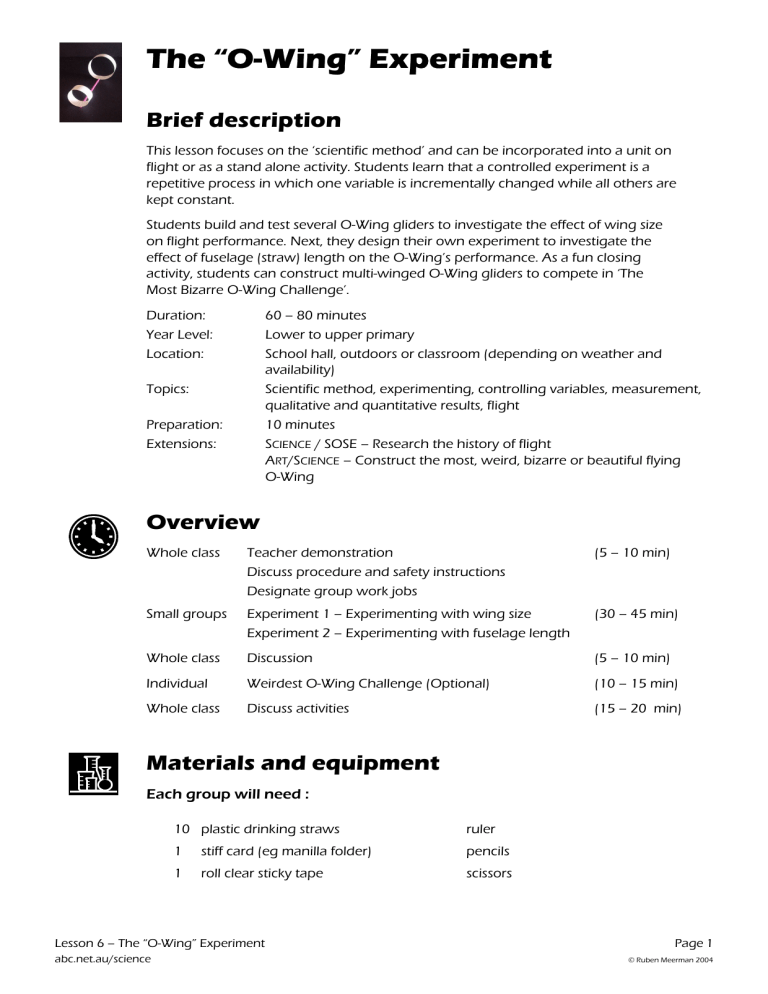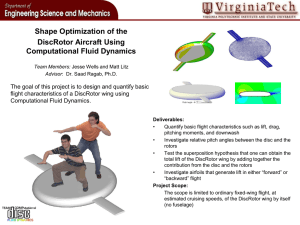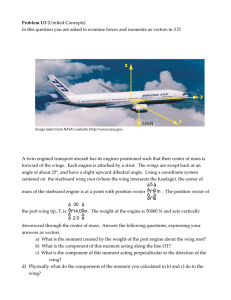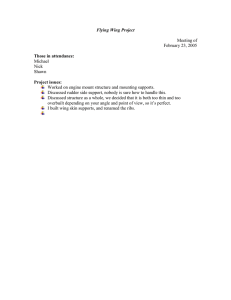
The “O-Wing” Experiment Brief description This lesson focuses on the ‘scientific method’ and can be incorporated into a unit on flight or as a stand alone activity. Students learn that a controlled experiment is a repetitive process in which one variable is incrementally changed while all others are kept constant. Students build and test several O-Wing gliders to investigate the effect of wing size on flight performance. Next, they design their own experiment to investigate the effect of fuselage (straw) length on the O-Wing’s performance. As a fun closing activity, students can construct multi-winged O-Wing gliders to compete in ‘The Most Bizarre O-Wing Challenge’. Duration: Year Level: Location: 60 – 80 minutes Lower to upper primary School hall, outdoors or classroom (depending on weather and availability) Scientific method, experimenting, controlling variables, measurement, qualitative and quantitative results, flight 10 minutes SCIENCE / SOSE – Research the history of flight ART/SCIENCE – Construct the most, weird, bizarre or beautiful flying O-Wing Topics: Preparation: Extensions: Overview Whole class Teacher demonstration Discuss procedure and safety instructions Designate group work jobs (5 – 10 min) Small groups Experiment 1 – Experimenting with wing size Experiment 2 – Experimenting with fuselage length (30 – 45 min) Whole class Discussion (5 – 10 min) Individual Weirdest O-Wing Challenge (Optional) (10 – 15 min) Whole class Discuss activities (15 – 20 min) Materials and equipment Each group will need : 10 plastic drinking straws ruler 1 stiff card (eg manilla folder) pencils 1 roll clear sticky tape scissors Lesson 6 – The “O-Wing” Experiment abc.net.au/science Page 1 © Ruben Meerman 2004 Preparation Materials for teacher to collect: y Sufficient quantities of straws and stiff card y Download and photocopy 30 student worksheets Objectives The objectives below are a guide only. You should check the outcomes statement for the year level of your class before deciding which of the following objectives are appropriate. Students’ prior knowledge Students are familiar with their group work job responsibilities. No prior knowledge of scientific concepts is assumed for this lesson. Science skills Experiment 1: Effect of wing size on O-Wing performance Students will: y follow the instructions accurately y identify the variables affecting the flight of an O-Wing y control as many variables as possible for each test flight of their O-Wing gliders y measure and record the length of each test flight y record their qualitative observations of each test flight y draw conclusions about the effect of wing size on the O-Wing’s performance y make suggestions for how their experiment could be improved to yield more accurate results Experiment 2: Effect of fuselage (straw) length on O-Wing performance Students will: y design an experiment to test for the effect of different fuselage (straw) lengths on the O-Wing’s performance y perform their experiment y measure and record their results y draw conclusions about the effect of wing size on the O-Wing’s performance y make suggestions for how their experiment could be improved to yield more accurate results Positive attitudes Students will: y work cooperatively in small groups y ensure each member has an opportunity to see and understand the activities y handle equipment and materials carefully and responsibly y use materials sparingly and dispose of waste responsibly Lesson 6 – The “O-Wing” Experiment abc.net.au/science Page 2 © Ruben Meerman 2004 Procedure Selecting a suitable location for test flights A school hall is the best location for the test flights if available. The test flights can also be performed outdoors on a clear, still day. If neither of these options are available, the classroom can be cleared for the test flights, however it may be more appropriate to conduct the test flights in a whole class activity to reduce traffic and provide a clear flight path for each test. Introduction (Whole class / 5 – 10 min) y Demonstrate the construction of an O-Wing and ask the class if they expect this strange contraption will actually fly (most people are quite surprised to see an OWing glide), then demonstrate its flight y Discuss the first O-Wing experiment to be conducted and logistics of test flying (see teacher notes) y Ask students to identify, and discuss all the variables that might affect each test flight and how these might be controlled – these include, but are not limited to: force of throw (or initial velocity) height of release angle to the ground at release (eg throwing horizontal or up toward the sky) angle of the wings to the ground (eg wings above straw, or wings below straw) wind y Distribute and discuss worksheets (if averaging has not yet been covered, discuss how the average of the tests will be calculated) y Allocate group work jobs and badges (if using group work model) y Prepare the room for experiments and test flights Experiment 1: Effect of Wing Size (Small groups / 15 – 20 min) y All group members read the instructions and cooperate to prepare a work station y All group members contribute to the successful completion of the experiment y WHOLE CLASS DISCUSSION – briefly discuss the results of the first experiment Experiment 2: Effect of Fuselage Length (15 – 20 min) y All group members contribute the experiment design and discuss and appropriate procedure y All group members cooperate to complete the experiment Conclusion (Whole class / 10 – 15 min) y Discuss the results of the two experiments y Demonstrate the effect of adding ballast (weight) to the front of the O-Wing glider (see teacher notes) y Set the construction challenge for the weirdest / most beautiful / most intricate O-Wing Glider Lesson 6 – The “O-Wing” Experiment abc.net.au/science Page 3 © Ruben Meerman 2004 Teacher notes Experimental results In this lesson, the experimental results are not as important as the process and conclusions drawn by students. Large variations in the results for both of these experiments is to be expected between groups. This is because even with students’ best efforts, controlling the variables is quite difficult. Experiment 1: Effect of wing size on O-Wing performance Students are most likely to conclude that there is an optimum size for the smaller wing, which lies somewhere between having equal sized wings and a smaller wing size of 10 cm. Students should discover that the glider with equal size wings does not glide, but falls with the trajectory of a leaf or feather (read about adding ballast below). The smallest wing will most likely result in shorter flights. Remember that students should arrive at whatever conclusion their results point to, so if there is disagreement among groups, it is worth discussing how this might have come about, rather than forcing agreement. Experiment 2: Effect of fuselage length on O-Wing performance Students are most likely to conclude that a longer fuselage results in better performance, up to a straw length of approximately 3 or 4 straws. However, this too may vary between groups and a discussion of why results may vary would be more fruitful than deciding who made mistakes (if any). Add ballast for another surprising result At the end of the lesson, you can again surprise your class by demonstrating the effect of adding a paperclip as ballast to the front of an O-Wing glider. Start with an glider which has equal sized wings and ask the class to recall their earlier result. Show them how a paper clip can be added to front of this O-Wing. This O-Wing will now fly just as well as an O-Wing with unequally sized wings. Lesson 6 – The “O-Wing” Experiment abc.net.au/science Page 4 © Ruben Meerman 2004 Weird and wonderful O-Wings Adding ballast to the front of any O-Wing glider that is not performing well can significantly improve its flight. Armed with this new knowledge, you can now challenge students to build the most weird and wonderful O-Wings possible, either as a homework task, or extension activity on this lesson. Both O-Wings pictured below glide beautifully and some improvement can be gained by adding a ballast paperclip to the front. Lesson 6 – The “O-Wing” Experiment abc.net.au/science Page 5 © Ruben Meerman 2004 . The ‘O-Wing’ Experiment Name ______________________________________ Materials required: Plastic drinking straws Thick card Sticky Tape Scissors Ruler Pencils Making an O-Wing: 1. Carefully cut a strip of card to the size required 2. Put a piece of sticky tape on the end of the strip. Curl it over so the ends overlap a little and stick down. It helps to tape down the inside of the wing too. 3. Lay a piece of tape on the table, sticky side up. Stick the straw onto the middle of the tape. Push the wing onto the tape and secure it carefully. 4. Centre both wings on the straw carefully like this. Flying an O-Wing Hold the O-Wing in the middle of the straw The “O-Wing” Experiment – Student Worksheet ABC Science Online ( abc.net.au/science ) Throw horizontally and gently Page 1 © Ruben Meerman 2004 O-Wing Experiment1: Wing size experiment Introduction You are going to conduct a scientific experiment to find out if O-Wings fly better with different size wings, or wings that are the same size. You will make and test fly several O-Wings and record the results of each test flight. Variables For the results of your experiment to be useful, each test flight must be conducted under the same conditions. This means you need to control the variables that affect an O-Wing’s flight as best you can. Write down all the variables you can think of, that might affect the O-Wing. How can you control each of these variables? Procedure Make four O-Wings as described below. Use strips that are 2.5 cm wide for ALL the wings (ie both large and small wings) O-Wing Number Small wing length Large wing length 1 25 cm 25 cm 2 20 cm 25 cm 3 15 cm 25 cm 4 10 cm 25 cm The “O-Wing” Experiment – Student Worksheet ABC Science Online ( abc.net.au/science ) Page 2 © Ruben Meerman 2004 Results Conduct the test flights and record your results in the table below. There is also space below to write down any observations about how well each O-Wing flew (eg did it glide, or spin out of control). Table 1 – O-Wing test flight results Small Wing Size Distance flown Test 1 Test 2 Test 3 Average 25 cm * (*equal size wings) 20 cm 15 cm 10 cm Observations Conclusions What conclusions can you draw from the results of your experiment? Can you think of any ways to improve the experiment? The “O-Wing” Experiment – Student Worksheet ABC Science Online ( abc.net.au/science ) Page 3 © Ruben Meerman 2004 O-Wing Experiment2: Fuselage length experiment Introduction Now that you have seen how a simple O-Wing experiment can be designed and conducted, it’s your turn. Devise an experiment to find out how the length of the straw affects the performance of the O-Wing. Use the space provide, or your science journal to record your experiment. You can cut straws to shorter lengths, or join several straws together to make longer lengths. The “O-Wing” Experiment – Student Worksheet ABC Science Online ( abc.net.au/science ) Page 4 © Ruben Meerman 2004 The “O-Wing” Experiment – Student Worksheet ABC Science Online ( abc.net.au/science ) Page 5 © Ruben Meerman 2004






